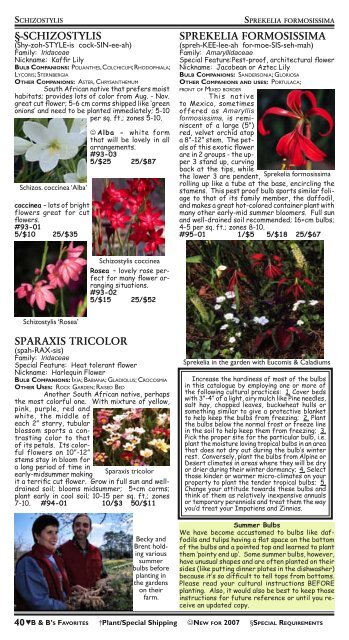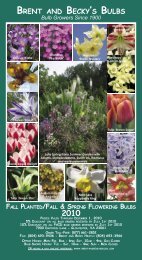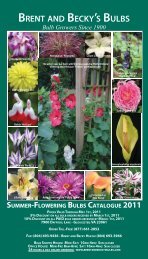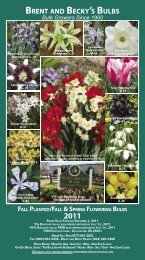2007 Summer Catalogue December 7 2006.indd - Brent and ...
2007 Summer Catalogue December 7 2006.indd - Brent and ...
2007 Summer Catalogue December 7 2006.indd - Brent and ...
Create successful ePaper yourself
Turn your PDF publications into a flip-book with our unique Google optimized e-Paper software.
SCHIZOSTYLIS<br />
§-SCHIZOSTYLIS<br />
(Shy-zoh-STYLE-is cock-SIN-ee-ah)<br />
Family: Iridaceae<br />
Nickname: Kaffir Lily<br />
BULB COMPANIONS: POLIANTHES, COLCHICUM; RHODOPHIALA;<br />
LYCORIS; STERNBERGIA<br />
OTHER COMPANIONS: ASTER, CHRYSANTHEMUM<br />
South African native that prefers moist<br />
habitats; provides lots of color from Aug. - Nov.<br />
great cut flower; 5-6 cm corms shipped like ‘green<br />
onions‛ <strong>and</strong> need to be planted immediately; 5-10<br />
per sq. ft.; zones 5-10.<br />
Schizos. coccinea ‘Alba’<br />
coccinea – lots of bright<br />
flowers great for cut<br />
flowers.<br />
#93-01<br />
5/$10 25/$35<br />
Alba - white form<br />
that will be lovely in all<br />
arrangements.<br />
#93-03<br />
5/$25 25/$87<br />
SPREKELIA FORMOSISSIMA<br />
SPREKELIA FORMOSISSIMA<br />
(spreh-KEE-lee-ah for-moe-SIS-seh-mah)<br />
Family: Amaryllidaceae<br />
Special Feature:Pest-proof, architectural flower<br />
Nickname: Jacobean or Aztec Lily<br />
BULB COMPANIONS: SANDERSONIA; GLORIOSA<br />
OTHER COMPANIONS AND USES: PORTULACA;<br />
FRONT OF MIXED BORDER<br />
This native<br />
to Mexico, sometimes<br />
offered as Amaryllis<br />
formosissima, is reminiscent<br />
of a large (5”)<br />
red, velvet orchid atop<br />
a 8”-12” stem. The petals<br />
of this exotic flower<br />
are in 2 groups - the upper<br />
3 st<strong>and</strong> up, curving<br />
back at the tips, while<br />
the lower 3 are pendent, Sprekelia formosissima<br />
rolling up like a tube at the base, encircling the<br />
stamens. This pest proof bulb sports similar foliage<br />
to that of its family member, the daffodil,<br />
<strong>and</strong> makes a great hot-colored container plant with<br />
many other early-mid summer bloomers. Full sun<br />
<strong>and</strong> well-drained soil recommended; 16+cm bulbs;<br />
4-5 per sq. ft.; zones 8-10.<br />
#95-01 1/$5 5/$18 25/$67<br />
Schizostylis coccinea<br />
Rosea – lovely rose perfect<br />
for many flower arranging<br />
situations.<br />
#93-02<br />
5/$15 25/$52<br />
Schizostylis ‘Rosea’<br />
SPARAXIS TRICOLOR<br />
(spah-RAX-sis)<br />
Family: Iridaceae<br />
Special Feature: Heat tolerant flower<br />
Nickname: Harlequin Flower<br />
BULB COMPANIONS: IXIA; BABIANA; GLADIOLUS; CROCOSMIA<br />
OTHER USES: ROCK GARDEN; RAISED BED<br />
Another South African native, perhaps<br />
the most colorful one. With mixture of yellow,<br />
pink, purple, red <strong>and</strong><br />
white, the middle of<br />
each 2” starry, tubular<br />
blossom sports a contrasting<br />
color to that<br />
of its petals. Its colorful<br />
flowers on 10”-12”<br />
stems stay in bloom for<br />
a long period of time in<br />
early-midsummer making<br />
Sparaxis tricolor<br />
it a terrific cut flower. Grow in full sun <strong>and</strong> welldrained<br />
soil; blooms midsummer; 5+cm corms;<br />
plant early in cool soil; 10-15 per sq. ft.; zones<br />
7-10. #94-01 10/$3 50/$11<br />
Becky <strong>and</strong><br />
<strong>Brent</strong> holding<br />
various<br />
summer<br />
bulbs before<br />
planting in<br />
the gardens<br />
on their<br />
farm.<br />
Sprekelia in the garden with Eucomis & Caladiums<br />
Increase the hardiness of most of the bulbs<br />
in this catalogue by employing one or more of<br />
the following cultural practices: 1. Cover beds<br />
with 3”-4” of a light, airy mulch like Pine needles,<br />
salt hay, chopped leaves, buckwheat hulls or<br />
something similar to give a protective blanket<br />
to help keep the bulbs from freezing; 2. Plant<br />
the bulbs below the normal frost or freeze line<br />
in the soil to help keep them from freezing; 3.<br />
Pick the proper site for the particular bulb, i.e.<br />
plant the moisture loving tropical bulbs in an area<br />
that does not dry out during the bulb‛s winter<br />
rest. Conversely, plant the bulbs from Alpine or<br />
Desert climates in areas where they will be dry<br />
or drier during their winter dormancy; 4. Select<br />
those kinder or warmer micro-climates on your<br />
property to plant the tender tropical bulbs; 5.<br />
Change your attitude towards these bulbs <strong>and</strong><br />
think of them as relatively inexpensive annuals<br />
or temporary perennials <strong>and</strong> treat them the way<br />
you‛d treat your Impatiens <strong>and</strong> Zinnias.<br />
<strong>Summer</strong> Bulbs<br />
We have become accustomed to bulbs like daffodils<br />
<strong>and</strong> tulips having a flat space on the bottom<br />
of the bulbs <strong>and</strong> a pointed top <strong>and</strong> learned to plant<br />
them ‘pointy end up‛. Some summer bulbs, however,<br />
have unusual shapes <strong>and</strong> are often planted on their<br />
sides (like putting dinner plates in the dishwasher)<br />
because it‛s so difficult to tell tops from bottoms.<br />
Please read your cultural instructions BEFORE<br />
planting. Also, it would also be best to keep those<br />
instructions for future reference or until you receive<br />
an updated copy.<br />
40 ♥B & B’S FAVORITES †Plant/Special Shipping NEW FOR <strong>2007</strong> §SPECIAL REQUIREMENTS







